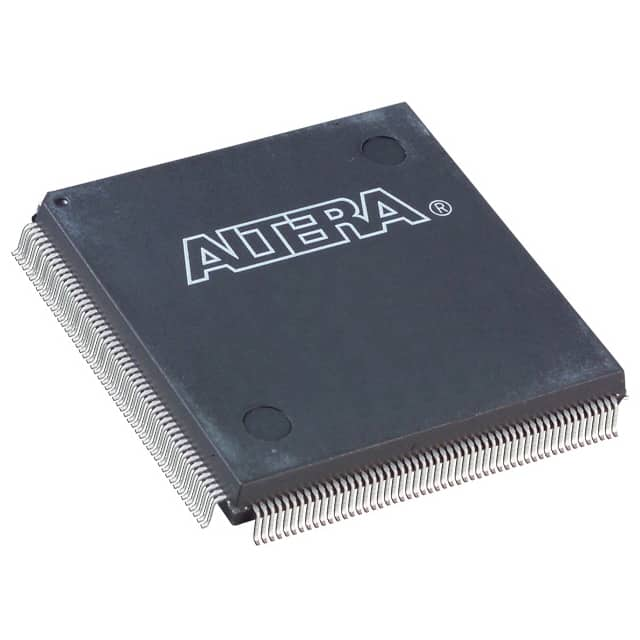EPF10K50SQC208-1X
Product Overview
Category
The EPF10K50SQC208-1X belongs to the category of programmable logic devices (PLDs).
Use
It is primarily used for digital circuit design and implementation.
Characteristics
- High-performance PLD with advanced features
- Offers flexibility in designing complex digital circuits
- Programmable to perform various logical functions
- Provides efficient utilization of resources
Package
EPF10K50SQC208-1X comes in a quad flat pack (QFP) package.
Essence
The essence of EPF10K50SQC208-1X lies in its ability to provide a versatile platform for digital circuit designers to implement complex logic functions.
Packaging/Quantity
The product is typically packaged individually and is available in varying quantities depending on the supplier.
Specifications
- Model: EPF10K50SQC208-1X
- Logic Elements: 50,000
- Maximum Operating Frequency: 200 MHz
- Number of I/O Pins: 208
- Supply Voltage: 3.3V
- Technology: SRAM-based
Detailed Pin Configuration
The EPF10K50SQC208-1X has a total of 208 pins, each serving a specific purpose in the circuit design. The detailed pin configuration can be found in the product datasheet.
Functional Features
- High-speed performance
- Large number of logic elements for complex designs
- Flexible input/output configurations
- On-chip memory for data storage
- Support for various communication protocols
- Built-in security features for protecting intellectual property
Advantages
- Versatile and flexible for implementing complex logic functions
- High-performance capabilities for demanding applications
- Efficient utilization of resources
- Support for various communication protocols enhances compatibility
- On-chip memory provides convenient data storage
Disadvantages
- Relatively high cost compared to simpler logic devices
- Steeper learning curve for beginners due to its complexity
- Limited availability of alternative models in the market
Working Principles
The EPF10K50SQC208-1X operates based on the principles of programmable logic. It consists of an array of logic elements that can be configured and interconnected to perform desired logical functions. The device is programmed using a hardware description language (HDL) or a graphical design tool, which generates a configuration file. This file is then loaded onto the PLD, enabling it to execute the specified logic functions.
Detailed Application Field Plans
EPF10K50SQC208-1X finds applications in various fields, including: - Telecommunications - Industrial automation - Automotive electronics - Aerospace systems - Medical equipment
In telecommunications, it can be used for signal processing, protocol conversion, and network management. In industrial automation, it enables control and monitoring of complex processes. In automotive electronics, it contributes to advanced driver assistance systems (ADAS) and engine control units (ECUs). In aerospace systems, it aids in avionics and flight control. In medical equipment, it assists in imaging systems and patient monitoring devices.
Detailed and Complete Alternative Models
While the EPF10K50SQC208-1X offers advanced features and capabilities, there are alternative models available in the market that cater to different requirements. Some notable alternatives include: - Xilinx Spartan-6 FPGA - Altera Cyclone IV FPGA - Lattice ECP5 FPGA - Microchip PolarFire FPGA
These alternative models provide varying levels of performance, capacity, and cost, allowing designers to choose the most suitable option for their specific application needs.
Word count: 511
قم بإدراج 10 أسئلة وإجابات شائعة تتعلق بتطبيق EPF10K50SQC208-1X في الحلول التقنية
Sure! Here are 10 common questions and answers related to the application of EPF10K50SQC208-1X in technical solutions:
Q1: What is EPF10K50SQC208-1X? A1: EPF10K50SQC208-1X is a specific model of Field Programmable Gate Array (FPGA) manufactured by Intel. It offers 10,000 logic elements and comes in a 208-pin Quad Flat Package.
Q2: What are the typical applications of EPF10K50SQC208-1X? A2: EPF10K50SQC208-1X can be used in various technical solutions such as digital signal processing, industrial automation, telecommunications, robotics, and embedded systems.
Q3: What are the key features of EPF10K50SQC208-1X? A3: Some key features of EPF10K50SQC208-1X include high-density programmable logic, on-chip memory blocks, built-in multipliers, and support for various I/O standards.
Q4: How can EPF10K50SQC208-1X be programmed? A4: EPF10K50SQC208-1X can be programmed using hardware description languages (HDLs) such as VHDL or Verilog, which describe the desired functionality of the FPGA.
Q5: Can EPF10K50SQC208-1X be reprogrammed after initial programming? A5: Yes, EPF10K50SQC208-1X is a field-programmable device, meaning it can be reprogrammed multiple times to implement different designs or modify existing ones.
Q6: What tools are available for programming EPF10K50SQC208-1X? A6: Intel provides software tools like Quartus Prime, which includes a complete development environment for designing, simulating, and programming EPF10K50SQC208-1X.
Q7: What is the power supply requirement for EPF10K50SQC208-1X? A7: EPF10K50SQC208-1X typically operates at a voltage range of 3.3V, but it also supports other common voltage levels used in digital systems.
Q8: Can EPF10K50SQC208-1X interface with external devices? A8: Yes, EPF10K50SQC208-1X has a variety of I/O pins that can be used to interface with external devices such as sensors, actuators, memory modules, or communication interfaces.
Q9: Is EPF10K50SQC208-1X suitable for real-time applications? A9: Yes, EPF10K50SQC208-1X can be used in real-time applications due to its high-speed performance and ability to implement complex logic functions efficiently.
Q10: Are there any limitations or considerations when using EPF10K50SQC208-1X? A10: Some considerations include power consumption, heat dissipation, and the need for proper signal integrity design techniques when working with high-frequency signals. Additionally, understanding the FPGA's architecture and limitations is important for optimal utilization.
Please note that these answers are general and may vary depending on specific requirements and use cases.


